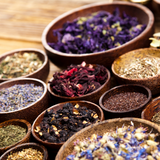Staying Informed: Bulk Herb Purchasing Limits & What You Need to Know
Mar 18th 2025
Staying Informed: Bulk Herb Purchasing Limits & What You Need to Know
At 1st Chinese Herbs, we’re committed to keeping you informed about the latest developments in the herbal world. As of today, March 18th, 2025, you may notice that certain bulk herbs have purchasing limits—this isn’t a cause for concern, but rather a response to factors like tariffs
…
The Ultimate Guide to Bulk Herbs: Unlocking the Power of Nature for Health and Wellness
Feb 16th 2025
Unlocking the Power of Nature for Health and Wellness
Why Have Herbs Been Used Through The Centuries?
For centuries, bulk herbs have played a crucial role in traditional medicine, culinary arts, and natural healing practices. Across ancient civilizations—from Traditional Chinese Medicine (TCM) and Ayurveda to Native American healing traditions—herbs have been cherished for their abilit
…
Skullcap Root - Scutellaria baicalensis
Posted by 1st Chinese Herbs on Aug 8th 2019
Nature’s
Therapeutic HerbWhat is
Skullcap? Where is it grown?Skullcap is
a flowering perennial plant in the Lamiaceae family with beautiful tubular blue flowers
that can be found growing on the grassy and sandy sea shores of Eastern Asia,
China, Japan, Korea and Mongolia. Skullcap
is also known as Chinese Skullcap and Baikal Skullcap. In traditional Chinese medicine it is call
Huang
…
Why You Should Be Using Bulk Herbs
Posted by 1st Chinese Herbs on Jun 3rd 2019
Medicinal herbs are a wonderful way to help your body work to
naturally improve your health. Herbal
products come in a variety of forms such as capsules, teas, supplements, loose
herbs and powders. While all these forms
have their advantages, loose herbs and powders give you more options for use.You may have seen cut and powdered herbs sold in 1-ounce
packages. The problem with this is whe
…




